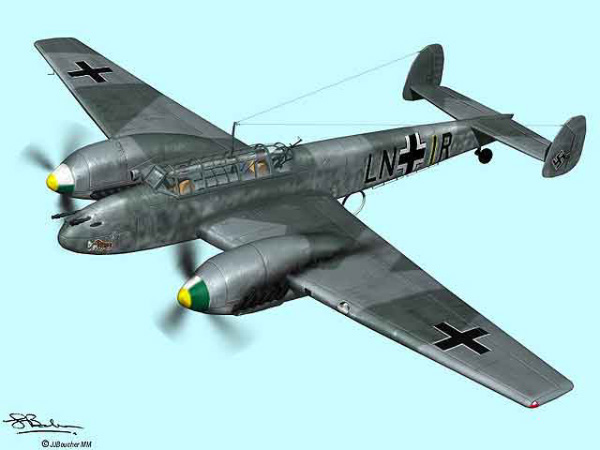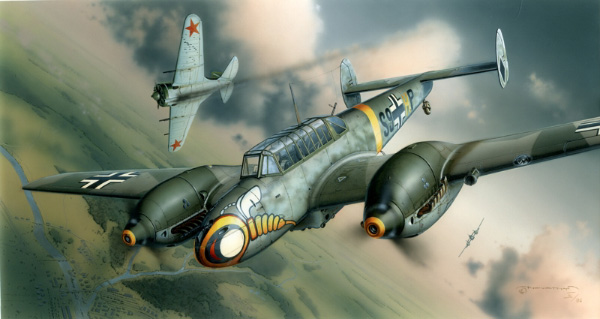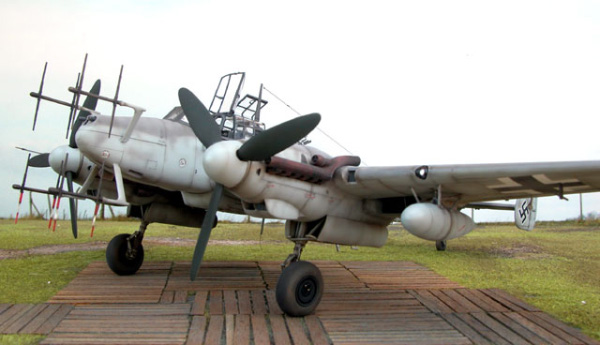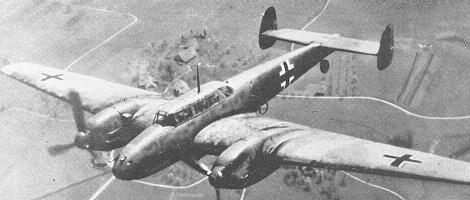
|
 |
Messerschmitt Bf 110 |
 |
 |
 |
 |
 |
|---|---|---|---|---|---|---|---|
 |
 |
 |
 |
 |
|||
 |
||
| As a long-range escort, fighter the Bf 110C received a disastrous mauling at the hands of the RAF during the "Battle of Britain." Rather than protecting the bombers under escort, the Bf 110C formations usually found that they were hard pressed to defend themselves.
The Messerschmitt Bf 110 was an aircraft of very mixed fortunes. It has often been criticized for its failure during the Battle of Britain, while its successes in other fields have been largely ignored. Yet, this aircraft that did not match up to Luftwaffe expectations, managed to serve Germany throughout the Second World War in long-range escort fighter, fighter-bomber, reconnaissance, ground attack and night fighter roles. |
| The long-range multi-seat escort fighter is possibly the most difficult of combat aircraft to design. Certainly no entirely successful machine in this category emerged from the Second World War, and when Professor Willy Messerschmitt began design studies for such a warplane towards the end of 1934, at the Bayerische Flugzeugwerke at Augsburg, his problems would have seemed insurmountable had he possessed a full knowledge of interceptor fighter development trends abroad. Such a machine as was required by Marshal Goering, to equip the elite zerstorer formations, that he envisaged had to be capable of penetrating deep into enemy territory, possessing sufficient range to accompany bomber formations. The fuel tankage necessary presented a serious weight penalty, and called for the use of two engines if the zerstorer was to achieve a performance approaching that of the lighter interceptor fighter by which it would be opposed. Yet it had to be maneuverable, if it was to successfully fend off the enemy's single-seaters. |
|
Messerschmitt possessed no previous experience with twin-engined military aircraft when he began work on the Bf 110. Indeed, his first warplane, the single-seat Bf 109 , had been
conceived only the previous summer. At the time, the most powerful aero engine of national
design available was the 610 hp Junkers Jumo 210A . It was obvious from the outset that a pair
of such engines would be inadequate to provide the power needed for the relatively large and
heavy fighter envisaged. However, the Daimler-Benz Aktiengesellschaft was actively engaged in
developing a new twelve-cylinder liquid-cooled inverted-vee engine, the DB 600 , which held promise of 1,000 hp, and on the premise that such engines would be available for his prototypes—Messerschmitt began the design of the Bf 110.
Designed to a 1934 requirement for a long range escort fighter, the first prototype Bf 110 made its initial flight on May 12, 1936. A key factor in the design was the use of two Daimler-Benz DB 600 engines—subsequent difficulty in obtaining enough of these to power development aircraft meant that the Bf 110 could not be tested during the Spanish Civil War. Nevertheless, one aircraft was tested at the Rechlin evaluation center in 1937, and proved to be very fast, although not as maneuverable as hoped. Despite obvious shortcomings, the Bf 110 entered service in 1939 as the Bf 110C—powered by two 1100 hp DB 601A engines. Production was set up on a massive scale, and by the end of the year, some 500 Bf 110s were flying operationally.

The Bf 110 was no match for the Thunderbolts escorting American B-17 and B-24 bombers over Berlin, and were transferred to the Russian front. By the time Germany invaded Poland on September 1, 1939, ten Luftwaffe Gruppen were equipped with the heavy fighter. Owing to the limited aerial opposition, the Bf 110C was largely employed in the ground-support role, and after the fall of Poland, little was heard of this much-vaunted machine until, on December 14, 1939, it was encountered by a formation of twelve Wellingtons over the Heligoland Bight. But it was not until it was to come up against RAF fighters in 1940, that the Bf 110C was to receive its first real trial in combat and to be found wanting. As a long-range escort fighter, the Bf 110C received a disastrous mauling at the hands of the more nimble Hurricane and Spitfire during the Battle of Britain. Rather than protecting the bombers under escort, the Bf 110C formations usually found that they were hard pressed to defend themselves. The complete failure of the Bf 110C in the role for which it had been conceived led to its eventual withdrawal from the Channel coast but did not result in any reduction in its production priority. While every publication on the Messerschmitt Bf 110 boasts about its mauling during the Battle of Britain, the fact that the "escorts needed to be escorted" is just not true according to British author John Vasco. He has authored eight books on the Messerschmitt Bf 110 and has conducted dozens of interviews with German pilots during the 1980s and 90s. According to German pilots who were there, the Bf 109 was no more successful than the Bf 110. The misstatement seems to have arisen by Hermann Göring's rants about the losses of 110s at one point during the Battle, who was seeking to point blame at others in order to divert attention from his own ill-conceived strategy. Gunther Rall, third most successful fighter ace in history said of Göring, "To be fair, he (Goring) was a great organizer before the war. He ran several political economic programs, but he was certainly not a strategist. About air warfare, he was mistaken."1 Vasco gives many examples in his books. “In the early days of July, III./ZG 76 suffered losses on an escort mission for Stukas against shipping in the Channel. The 110 units also escorted He 111, Ju 88 & Do 17 units during the Battle. The majority of their missions were flying as pure escort units more often than not. Flying at around 200 mph or less, with the slow, lumbering, bombers, they were bounced often by RAF fighters flying considerably faster, up towards 300 mph and above, they were often at a great disadvantage, hence the level of their losses." The 110 units flew in far greater roles than the 109 units, and Bf 109 units arrived at the Channel front much later than the Bf 110 units, which no doubt reduced Bf 109 losses than they otherwise would have been.2 Against Polish PZL fighters and other European countries, the aircraft fared well. Although the Bf 110s had failed in their primary task, production continued at a high rate, and by 1945 no fewer than 6,150 had been built, ranging from Bf 110As to Gs. As later models became available, the early Bf 110Cs and Ds were transferred to the Middle East and Eastern Front. Both the C- and D-models had almost disappeared from the European theatre by the summer of 1941, although they were being used extensively on the Russian front and in the Middle East. Production during 1940 had risen to 1,083 machines, but with the impending introduction of the Me 210, only 784 machines were produced in the following year. By the end of 1942, in which year 580 Bf 110s were produced, production of this aircraft had again been stepped up as, on April 17, production of the Me 210 was canceled after numerous accidents, thus leaving a serious gap in the Luftwaffe's fighter and fighter bomber production program. To fill the gap, an improved version of the Bf 110 was introduced, the G-series with the DB 605 engine which provided 1,475 hp for take-off and 1,355 hp at 18,700 feet. The pre-production Bf 110G-0 fighter-bomber was delivered for service evaluation late in 1942, and from early in 1943, G-series machines were encountered in increasing numbers. Apart from its engines the first production model, the Bf 110G-1, was similar to earlier fighter-bomber variants, and the G-2 differed principally in the armament installed: two or four 20-mm. MG 151 cannon and four 7.9-mm. MG 17 in the nose plus two 7.9-mm. MG 81 in the rear cockpit.

The Bf 110G, was intended for use originally as a fighter-bomber but, it was employed mostly as a night fighter. Shown above is a Bf 110G-4. The Bf 110Es were capable of carrying a respectable bomb load of 4,410 lb (2,000 kg) as fighter-bombers, while straight fighter and reconnaissance versions were also built. These, and later versions, were operated with a fair degree of success in many war zones. The Bf 110F was basically similar to the E, but two new variants were produced—the 110F-2 carrying rocket projectiles, and the F-4 with two 30 mm cannon, and an extra crew member for night fighting. The last version, the Bf 110G, was intended for use originally as a fighter-bomber but, in view of the success of the F-4, and the increasingly heavy attacks on Germany by Allied bombers, was employed mostly as a night fighter. From time to time, Bf 110G night fighters were used on day operations. They were first employed as close escort to the Scharnhorst, and the Gneisenau off the Dutch coast and Heligoland Bight, and in the summer of 1943, they fought American day-bomber formations, whenever the latter flew unescorted. The Bf 110G groups sustained heavy losses during these actions owing to their pilots, trained in night-fighting tactics, going in close before attacking and being met by the heavy defensive fire of the bombers. They were no match for the Thunderbolts escorting American B-17 and B-24 bombers over Berlin. It was in a Bf 110 that Rudolf Hess, Deputy Fuhrer of Germany, flew solo to Scotland on the night of May 10, 1941, in the hope of negotiating peace terms with Britain, without Hitler's knowledge.

From time to time Bf 110G night fighters were used on day operations. They fought American day-bomber formations whenever the Americans flew unescorted. When compared to other twin-engine aircraft such as the Bristol Beaufighter, de Havilland Mosquito, Petlyakov Pe-2 and Lockheed P-38, the biggest mistake was that the Bf 110 was built to fulfill too many roles. The Beaufighter, Mosquito and Pe-2 were never intended to be fighters and the P-38’s main role was as a fighter. Hitler’s obsession with offensive capabilities required the Germans to produce aircraft with multiple roles that compromised performance as opposed to the Allies who produced aircraft that were more specialized. |
| Specifications: | |
|---|---|
| Messerschmitt Bf 110G-4 | |
| Dimensions: | |
| Wing span: | 53 ft 4-7/8 in (16.27 m) |
| Length: | 41 ft 6 3/4 in (12.67 m) |
| Height: | 13 ft 1 1/4 in (4.0 m) |
| Weight: | |
| Empty: | 10,970 lb (4,975 kg) |
| Maximum loaded: | 21,800 lb (9,888 kg) |
| Performance: | |
| Maximum Speed: |
311 mph (500 km/h) at sea-level. 342 mph (550 km/h) at 22,900 ft. (6,979 m) |
| Service ceiling: | 26,000 ft (7,924 m) |
| Range: | 1,305 miles (2,100 km) with maximum internal fuel. |
| Powerplant: | |
|
Two Daimler-Benz DB 605B twelve cylinder inverted-vee liquid
-cooled engines rated at 1,475 hp (1,099 kW) at 2,800 rpm for take-off and,
1,355 hp (1,010 kW) @ 2,800 rpm at 18,700 ft. (5,699 m). | |
| Armament: | |
|
Two 30-mm. MK 108 cannon and two 20-mm. MG 151 cannon in nose and, two flexible 7.9-mm. MG 81 machine-guns in rear cockpit. | |
Endnotes:
|
1. Wings of the Luftwaffe, Bf 110 Destroyers. Produced by Colin Grubb. Network Projects. 44 minutes. Video. 1992. 2. John Vasco. Zerstörer: Messerschmitt 110 and Its Units in 1940. Personal email (November 5, 2013). |
© The Aviation History Online Museum.
All rights reserved.
Created October 29, 1996. Updated November 15, 2013.